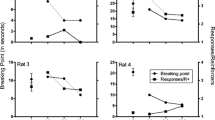Abstract
Total caloric intake and dietary self-selection of the three macronutrients protein, fat, and carbohydrate were examined in male rats maintained on a 6-h feeding schedule following the administration of the opioid antagonist naloxone HCl (0.1, 1.0, and 10.0 mg/kg IP). Total caloric intake (calculated as the sum of caloric intakes from each of the macronutrients) was decreased for up to 2 h following naloxone administration. By the end of the 6-h feeding period, however, no differences in total caloric intakes were observed as a function of naloxone injections. Examination of intakes of the individual macronutrients revealed that naloxone differentially affected fat, carbohydrate, and protein consumption. Across the 6-h feeding period, animals consumed less calories from the fat ration following all three doses of naloxone than after saline injections. Carbohydrate intake was decreased for up to 2 h following naloxone injections, but returned to control values by the end of the 6-h feeding period. Protein intake, in contrast to fat and carbohydrate intakes, did not vary as a function of naloxone administration. Results of the present experiment are contrasted with patterns of dietary self-selection observed following morphine administration.
Similar content being viewed by others
References
Beaumont A, Hughes J (1979) Biology of opioid peptides. Annu Rev Pharmacol Toxicol 19:245–267
Blundell JE, Latham CJ (1980) Characterisation of adjustments to the structure of feeding behavior following pharmacological treatment: Effects of amphetamine and fenfluramine and the antagonism produced by pimozide and methergoline. Pharmacol Biochem Behav 12:717–722
Brands B, Thornhill JA, Hirst M, Gowdey CW (1979) Suppression of food intake and body weight gain by naloxone in rats. Life Sci 24:1773–1778
Brown DR, Holtzman SG (1979) Suppression of deprivation-induced food and water intake in rats and mice by naloxone. Pharmac Biochem Behav 11:567–573
Cooper SJ (1980) Naloxone: Effects on food and water consumption in the nondeprived and deprived rat. Psychopharmacology 71:1–6
Frenk M, Rogers, GH (1979) The suppressant effects of naloxone on food and water intake in the rat. Behav Neural Biol 26:23–40
Grandison L, Guidotti A (1977) Stimulation of food intake by muscimol and beta-endorphin. Neuropharmacology 16:533–536
Guillemin R (1980) β-Lipotropin and endorphins: Implications of current knowledge. In: Krieger DT, Hughes JC (eds) Neuroendocrinology. Sinauer Associates, Sunderland, p 67
Hetherington AW, Ranson SW (1942) The relation of various hypothalamic lesions to adiposity in the rat. J Comp Neurol 76:475–499
Holtzman SG (1974) Behavioral effects of separate and combined administration of naloxone and d-amphetamine. J Pharmacol Exp Ther 189:51–60
Holtzman SG (1979) Suppression of appetitive behavior in the rat by naloxone: Lack of effect of prior morphine dependence. Life Sci 24:219–226
Kanarek RB, Feldman PF, Hanes C (1981a) Patterns of dietary selfselection in VMH-lesioned rats. Physiol Behav (in press)
Kanarek RB, Ho L, Meade RG (1981b) Sustained decrease in fat consumption produced by amphetamine in rats maintained on a dietary self-selection regime. Pharmacol Biochem Behav 14:539–542
King BM, Castellanos FX, Kastin AJ, Berzas MC, Mauk MD, Olson GA, Olson RD (1979) Naloxone-induced suppression of food intake in normal and hypothalamic obese rats. Pharmacol Biochem Behav 11:729–732
Kuhar MJ, Pert CB, Snyder SH (1973) Regional distribution of opiate receptor binding in monkey and human brain. Nature 245:447–450
Margules DL, Moisset B, Lewis MJ, Shibuya H, Pert CB (1978) β-Endorphin is associated with overeating in genetically obese mice (ob/ob) and rats (fa/fa). Science 202:988–991
Marks-Kaufman R, Kanarek RB (1980) Morphine selectively influences macronutrient intake in the rat. Pharmacol Biochem Behav 12:427–430
Morley JE (1980) The neuroendocrine control of appetite: the role of the endogenous opiates, cholecystokinin, TRH, gamma-amino-butyric acid and the diazepam receptor. Life Sci 27:355–368
Orthen-Gambill N, Kanarek RB (1981) Differential effects of amphetamine and fenfluramine on dietary self-selection in rats. Pharmacol Biochem Behav (in press)
Powley TL (1977) The ventromedial hypothalamic syndrome, satiety and a cephalic phase hypothesis. Psychol Rev 84:89–126
Rogers GH, Frenk H, Taylor AN, Liebeskind JC (1978) Naloxone suppression of food and water intake in deprived rats. Proc West Pharmacol Soc 21:457–460
Sanger DJ, McCarthy PS (1980) Differential effects of morphine on food and water intake in food deprived and freely feeding rats. Psychopharmacology 72:103–106
Wikler A (1980) Opioid dependence. Mechanisms and treatment. Plenum Press, New York
Wei E, Loh EH, Way EL (1973) Quantitative aspects of precipitated abstinence in morphine-dependent rats. J Pharmacol Exp Ther 184:398–403
Author information
Authors and Affiliations
Rights and permissions
About this article
Cite this article
Marks-Kaufman, R., Kanarek, R.B. Modifications of nutrient selection induced by naloxone in rats. Psychopharmacology 74, 321–324 (1981). https://doi.org/10.1007/BF00432739
Received:
Accepted:
Issue Date:
DOI: https://doi.org/10.1007/BF00432739



